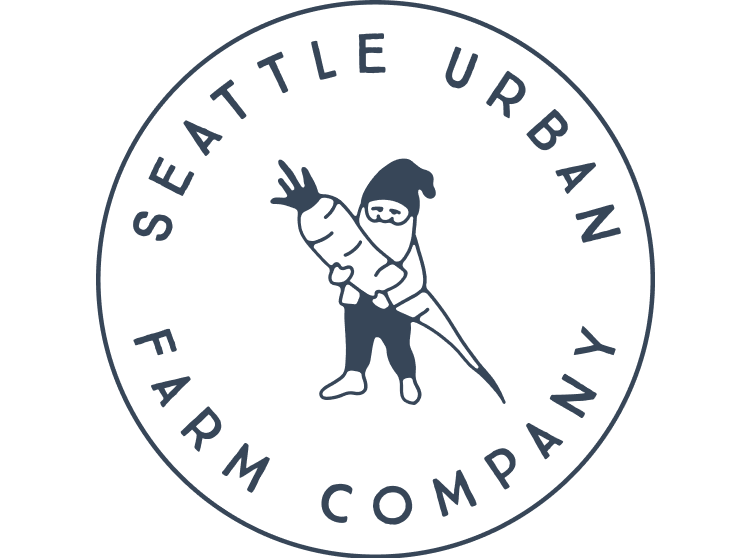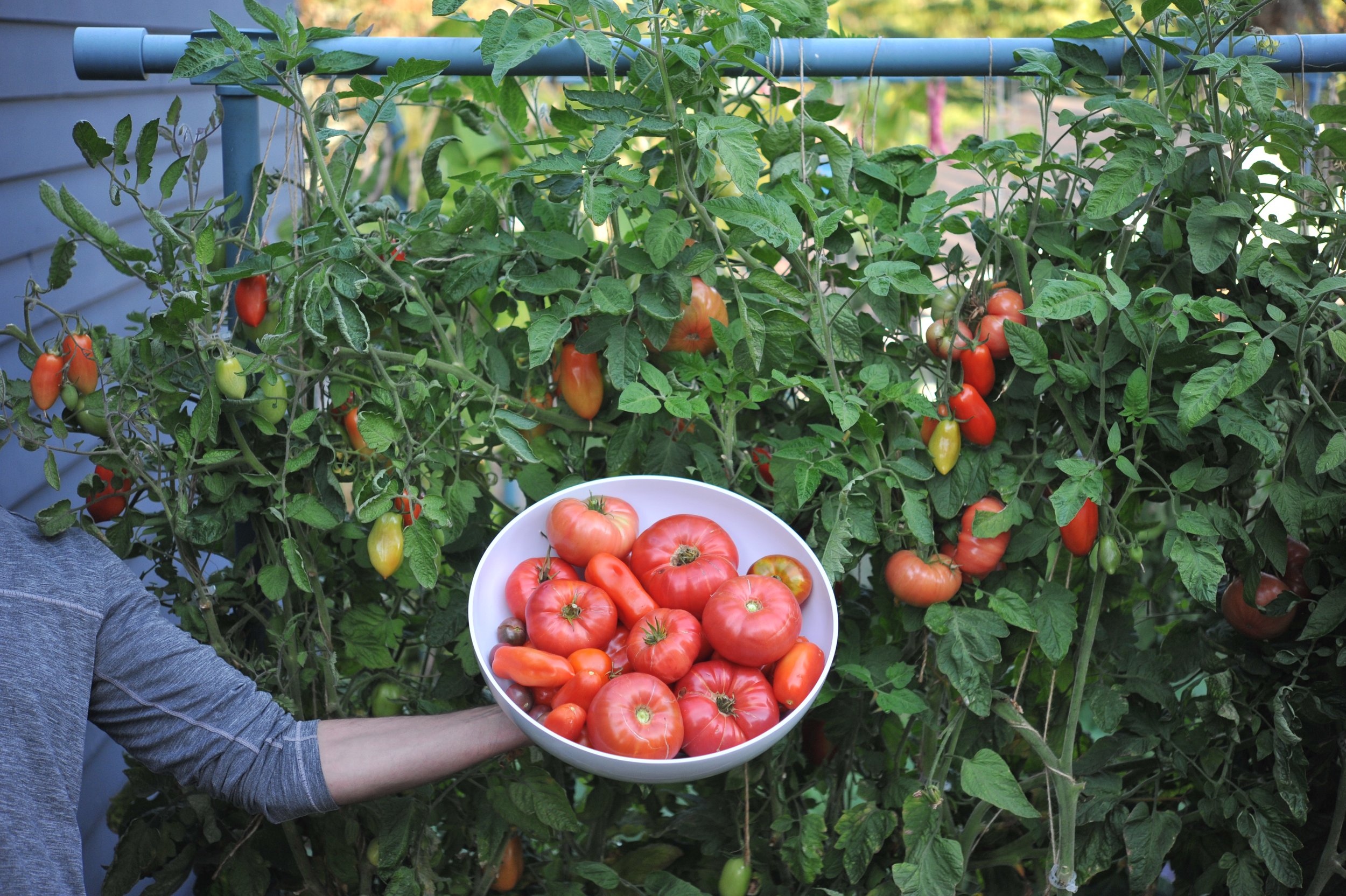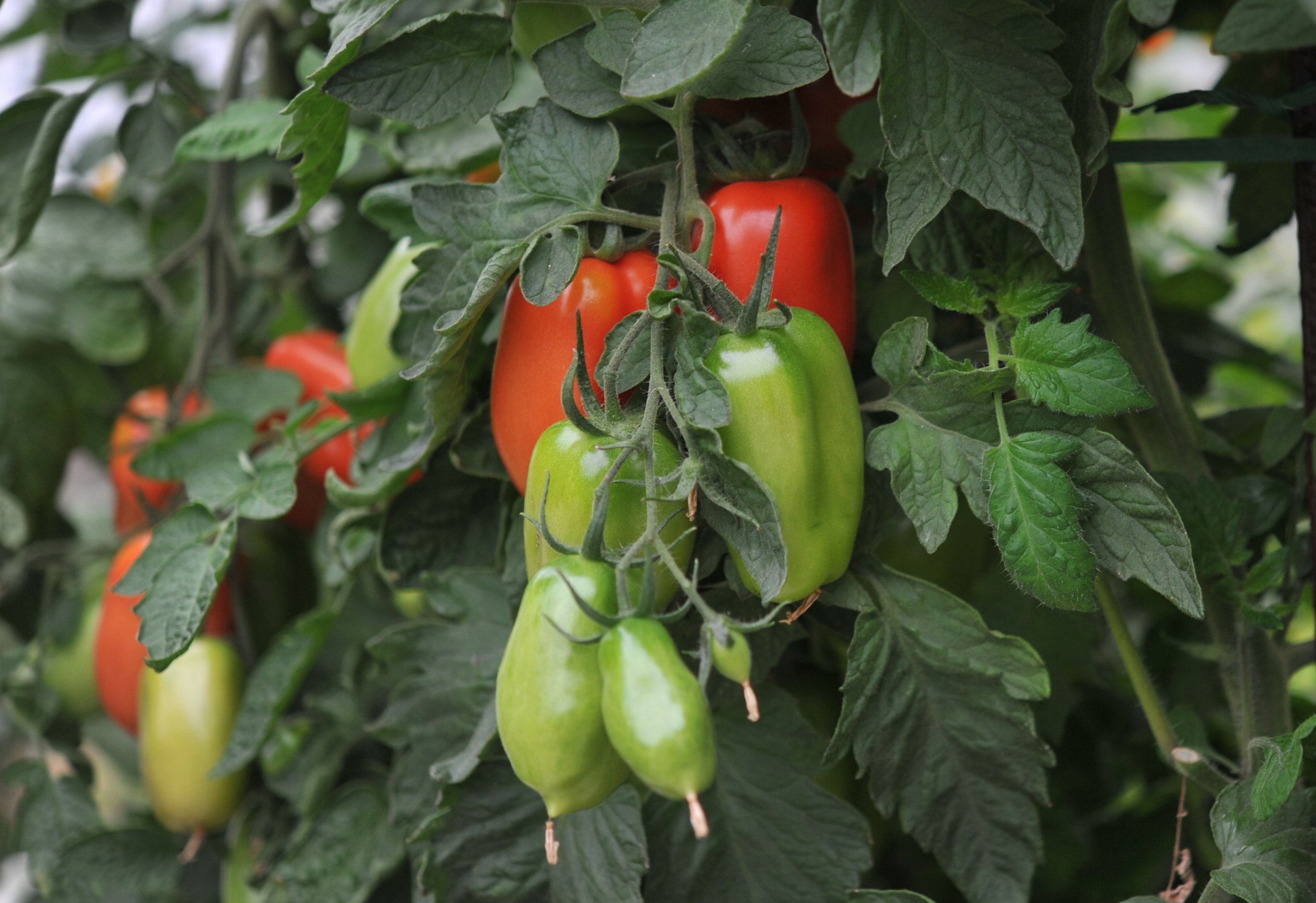Tomatoes
Lycopersicon esculentum
Tomatoes are an incredible crop and probably the most popular garden vegetable. The tomato originated in South America and eventually made its way into the cuisine of just about every culture on the planet. There are many stories about the slow adoption of tomatoes in parts of Europe due to its similarity to poisonous nightshade plants. But eventually the temptation of the sweet, prolific fruits won out over the fear of a horrible death, and pizza was born. Tomatoes contain vitamins A and C and a host of healthful phytochemicals such as lutein and lycopene.
Types of tomato plants
There are two main types of tomato plants you can grow. This is an important distinction, so remember to look for the type on each seed packet or plant tag:
Determinate tomato plants grow to a certain height, then flower and set fruit over a short period of time. Determinate tomatoes can be grown on a shorter trellis. Since all of the fruit mature at the same time, they are generally grown for preservation and canning; many determinate types are Roma or plum tomatoes.
Indeterminate tomato plants will continue to grow larger and larger through the season and continue to set fruit for many weeks (usually until the end of the season, when they are killed by cold or wet weather). Indeterminate tomatoes require a tall trellis. Most cherry tomatoes and many slicing tomatoes are indeterminate varieties.
Tomatoes come in a variety of shapes and sizes. Some principal categories are:
Cherry, Grape: Small, very sweet tomatoes usually eaten whole. Usually indeterminate plants.
Slicing, Beefsteak: Large tomatoes used for slicing for sandwiches, for caprese salad, you name it. Usually indeterminate plants.
Plum, Roma: Medium-sized fruit, usually with an oblong, narrow shape (similar to a plum), used for sauces and for canning. Usually determinate plants.
How to trellis tomatoes
Tomatoes are vines and grow best when supported by a trellis. Unlike some other vining vegetable crops (such as peas, cucumbers, and pole beans), tomatoes don’t have tendrils. This means that they don’t grab onto a vertical support in the same way that other crops do. This makes trellising slightly more complicated, but also more satisfying when done right.
A supporting your tomatoes properly will ensure that:
The branches don’t break: which would reduce your harvest and make them more susceptible to disease.
The fruits are easy to harvest: because you’ll have access to the fruits closer to eye level and without needing to dig through the foliage on the ground.
The fruits are more likely to mature: trellises tomatoes have better access to sunlight and airflow, making them more likely to mature (so you can eat them!).
The fruits are less prone to pest damage: tomatoes grown on the ground are easy targets for pests of all kinds, including insects, rodents, and birds.
The plants look attractive: a well-trained tomato is a thing of beauty and makes your garden much more enjoyable to spend time in.
Cherry tomatoes and slicing tomatoes growing on vertical strings on Dandelion yellow Freyr trellises
Vertical string trellising: Our preferred technique is to support tomato plants on vertical strings. Growing tomatoes this way is the reason we invented the Freyr trellis. Growing on vertical strings is easy:
Hang 1 string for each main leader of your tomato. The number of leaders will depend on your preference. Some people like to have 1 leader, others prefer 2 or 3. We like to keep 4-5 leaders per plant. This means you’ll just hang 4 or 5 strings for each tomato plant and train 1 leader per string.
Gently wrap the leader around the string as it grows. New tomato growth is very pliable and easy to work with. We recommend training your tomatoes about once a week. Older growth gets more stiff and is more likely to break, so the more often you train, the easier it is!
Add trellis clips as needed. We like to clip the string to the base of our plant and then add a clip every few feet as they grow. Clips are especially helpful if the growth is a little older and you think it’s likely to snap. Just add a clip instead of twisting the branch around the twine.
Remove extra branches as the plants grow (more on pruning below).
Horizontal string trellising: Another great way to support tomatoes with strings. This technique is also called the Florida weave or stake-and-weave.
Simply tie a string onto a vertical support on one end of your row of tomatoes. Weave the string down the row so that it goes in front of the first plant, behind the second plant, in front of the third plant, and so on.
When you reach the post at the other end of the row, wrap it and go back along the row in the opposite direction.
Repeat this process every time the plants grow 6-12”.
Other trellising techniques: We love string trellising, but here are a few other ways to support your tomato plants.
Tomato cage: Cages make trellising simple, but keep in mind that many cages may be too short for your plants. If your plants overgrow the top of the cage, the branches are likely to break. It’s also easy to lose track of your fruit in the middle of the cage, so make sure that you’re checking our your plants regularly so you don’t miss your harvest!
Single stakes: You can grow each tomato plant on a single vertical stake made of a strong material. Just make sure that the stake is at least 5-7’ tall (for indeterminates) and strong enough to remain straight when the plant is mature and loaded with fruit. Rebar or another type of metal is a good option. Since tomatoes don’t wrap themselves or have tendrils, you’ll need to tie them regularly to the stake with twine to keep them upright.
more tomato basics
Here are a few key things to keep in mind when buying, growing, harvesting, and preserving your tomatoes:
What you eat: The fruit.
Recommended varieties: There are hundreds of varieties of tomatoes. Here are a few of our favorites:
Cherry: Sungold, Sweet 100, White Currant
Slicing: Stupice, Moskvich, Big Beef, Black Prince, Cherokee Purple, Berkeley Tie-Dye, Black Krim
Roma: San Marzano, Window Box Roma
Hardiness: Frost will kill tomatoes.
Seed information: Germination temp. 60°–90°F, optimal 77°; germination time 14 days at 59°, 6 days at 77°. Seed viability 3–7 years.
Mature plant size: Up to 8 ft. tall and 36 in. wide.
How to plant: It’s crucial to start with large, healthy transplants. Look for plants with dark green vegetation in 4 in. or larger pots.
Space plants 18 in. apart. Snip the lowest side branches and the bottom set of leaves off of your transplants, and dig a hole deep enough for each plant to be buried up to the next lowest set of leaves. (Tomatoes set new roots out of the buried stem, so planting them this way gives them the opportunity to develop a large root structure very quickly.)
Add 1⁄4 cup of balanced fertilizer to the hole and mix with a trowel. Set the plant in the hole and fill it back in with soil.
When to plant: In most regions, tomatoes are best planted in late spring, mid- to late May in many areas.
How much to plant: Tomato yield is variable, but you’ll likely harvest 4–8 lb. per plant (up to 20 lb. in ideal conditions). We recommend starting with 2–6 plants for your first year.
When to fertilize: Before planting, and at 3 and 6 weeks after planting. Use 1⁄4 cup balanced fertilizer per plant, or liquid fertilizer.
General care: Prune and train your tomatoes to their trellis (see above). After the plants have started ripening their first fruits, you can consider reducing the amount you water them. Water-stressing your tomatoes will reduce the size of the tomatoes and the overall yield of the plants, but can encourage ripening and improve flavor.
Pests: Tomato hornworms, aphids, slugs, nematodes.
Diseases: Early and late blight, anthracnose, Verticillium and Fusarium wilt.
Container suitability: Good. Use 5 gal. pots or larger, or anything at least 12 in. in. deep.
When and how to harvest: Tomatoes taste best when ripened on the plant. They’re ready when fully red (or yellow, orange, or purple) and slightly soft to the touch. Harvest by cutting the stem just above the tomato, or by breaking it off with your hand. Tomatoes also ripen well off the vine if held at room temperature. This is useful for large tomatoes that don’t fully ripen on the vine, and in the fall when temperatures aren’t high enough to ripen the fruit outdoors.
Storage and preservation:
Counter: Tomatoes should be stored at 60°–70°F. A basket on the counter is perfect. Avoid the fridge unless you like mealy, tasteless tomatoes!
Freezer: You can puree fresh tomatoes, drain the excess liquid, and freeze them immediately, or you can cook the puree to the desired thickness and then freeze.
Dried: Sun-dried tomatoes.
Canned: Tomato sauce, salsa, whole or sliced tomatoes, paste.
How to Prune tomatoes
Pruning helps ensure high yields of fruit and greater ripening success, especially with indeterminate types.
It limits the overall number of tomatoes, so the plant can produce and ripen higher-quality fruits.
It increases air circulation through the plant (which helps keep disease down) and improves sunlight penetration (which helps with ripening).
Late-summer pruning reduces the production of late-season tomatoes, so that the plant has a better chance of ripening the existing fruit.
Generally speaking, determinate tomatoes need considerably less pruning than indeterminate types.
The ideal tomato plant has between 1-5 main stems (called leaders), with single lateral branches radiating from each stem. We recommend pruning tomatoes a few times over the course of the season to keep them under control. Prune by breaking excess branches off with your fingers, or use pruning shears if branches are too large to break.
A. At transplanting time, check the crotch of each branch. Break off any new branch growing from the crotch. Also, break off any forming flower buds.
B. Continue to check branch crotches each week and break off new branches. Also, break off any flower buds that appear for 2–3 weeks after transplanting.
C. Tie each leader to a string or other support. If the plant develops other large stems that compete with the leaders you’ve selected, cut them off.
D. Keep this basic structure going as the plant grows. Prune off any yellowing, dying, or diseased leaves. The plant will continue to grow, set new flowers, and fruit.
E. Starting in mid-August, prune off any new flower buds. This will keep the plant from setting fruit too late into the fall.
F. This process may sound kind of complicated, but you’ll do great! You’ll get more and more comfortable each time you prune.
This basic technique of selectively removing foliage can help you with managing diseases and improving air circulation for any fruiting crop.
Parts of this article are excerpts from our first book, Food Grown Right, In Your Backyard: A Beginner’s Guide To Growing Crops At Home (Mountaineers Publishing 2012).










In episode 123 of the Encyclopedia Botanica podcast, host Hilary Dahl and her husband and business partner, Colin McCrate discuss the benefits and methods of vertical and horizontal string trellising.